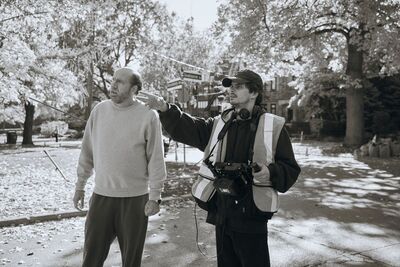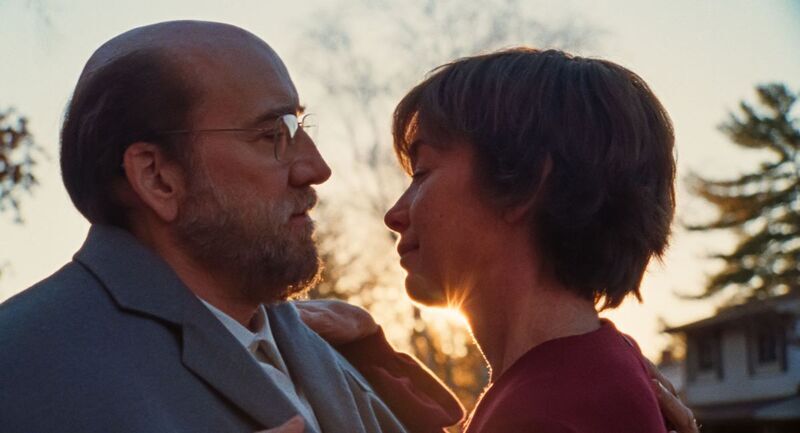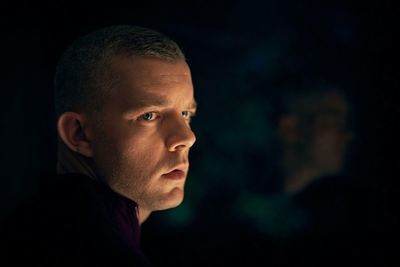Inside My Head: Kristoffer Borgli on Dream Scenario

Norwegian director Kristoffer Borgli isn’t afraid to push buttons with his work, but he’d also be the first to tell you that it’s always with sincere and hilarious purpose. From his disturbing short films to his 2022 feature, “Sick of Myself,” which features its protagonist mutilating her own body for attention, he often uses the grotesque as a launching point to critique people’s unhinged pursuit of fame. His latest film, the darkly hilarious tragicomedy “Dream Scenario,” tones back on the body horror but continues the director’s interrogation with fame and status, exploring the great violence we often commit in the lengths we go to be seen.
“Dream Scenario” focuses on evolutionary biology professor Paul Mathews (Nicolas Cage), whose dreams seem to be the most exciting thing about him. While he’s in a happy marriage to Janet (Julianne Nicholson) and father to two daughters, in all other areas of his life he feels dissatisfied. His classes have dwindling attendance, he hasn’t been able to get a long-coveted book project off the ground, and what little groundbreaking work he’s been able to produce, he suspects an old colleague might be trying to steal. Everything changes though once he starts randomly appearing in people’s dreams. Soon, he goes from being someone you wouldn’t give a second look at to being “the most interesting person in the world” as a branding executive (Michael Cera, in a quirky cameo role) says.
RogerEbert.com spoke to Borgli at the Chicago International Film Festival, the day after “Dream Scenario” premiered there to a sold-out screening. It was the director’s first time in Chicago and on a cloudy Fall Day not unlike the ones that greet the characters in the film, Borgli shared what he found fascinating about dreams as a narrative tool, how he and his team approached constructing those elaborate dream sequences, and how working on films like “Sick of Myself” and “Dream Scenario” have re-shaped his relationship to success.
This interview has been edited and condensed.
Dream sequences are central to “Sick of Myself” and, obviously, “Dream Scenario”. Have you always been fascinated with dreams and what makes them a compelling narrative tool in your stories?
I’ve been thinking a lot about this lately. I worked at a video store when I was sixteen for about three or four years. That’s when I fully fell in love with cinema and started thinking that maybe I could make movies one day. But I remember my surroundings in this little town in Norway looked nothing like the movies that I enjoyed. I was frustrated because I felt like there were no stories to tell there. Then I started thinking about how there was a place I could go though: inside my head. I thought of dreams as the most exciting location, and ever since I’ve been wanting to find a movie where I have an excuse to go into people’s heads. Now with “Dream Scenario,” you not only go into one person’s head, you go into thousands.
We spend a lot of our lives dreaming in bed, but we also spend our waking life mostly in our heads too. I feel like we’re not participating in reality as much as we are thinking about our past or the imagined future at any moment. That is a big part of the experience of life. I thought of this movie as a possibility of going there and exploring that. There’s a discrepancy between reality and what you dream about, and I wanted to put those two in dialogue and explore that tension.

My favorite dream was the one where a girl is trying to escape these alligators by climbing on top of a piano. You shared how some of the crew recreated those dream set pieces based on some of their own dreams. What went into constructing them though? Are the ones we see on-screen a smorgasbord of everyone’s dreams or are there a couple that are pulled directly from your life that you wanted to feature?
I used my own dreams as research material and I wanted them to feel the way they do when you dream them, not the way that you reflect on them with your rational, waking brain. That meant making sure that the dreams had real stakes. The audience needed to understand what was going on and feel the pain, suffering, and/or excitement that the dreamer has when dreaming it. A lot of this movie takes place in a very boring suburb and normal university so getting to go into these dreams became a very exciting contrast. I wanted the dreams to feel like we didn’t hold back, you know? In that dream you’re mentioning, those are real alligators. That was an intense shoot to have those alligators in this house and have these trainers push them around. For the earthquake dream, that one was all fully in-camera with no special effects at all. It was all really exciting stuff to look at and to shoot. It was just a joy as a director to sort of just go anywhere.
That must have been an interesting yet fun challenge because when you have dreams and then you try to explain it to someone, at least for me, I’m sure I miss details and forget to include some elements. For these dream sequences, you’re working backwards in a way and actively trying to flesh them out with details.
I think language is not a good enough tool to make people understand the gravity of a situation in a dream. Explaining and telling someone about a dream is the most annoying and boring thing that people can listen to. With this movie, I can show and allow the audience to live inside of the dream.
As a tangent to this idea of fleshing things out, I loved how you showed the “logistics of fame” in this film. If people around the world really did begin to have recurring dreams of this one person, how would that person’s family and life change? What prompted you to focus on these “initial” moments of fame before the crescendo into madness?
I wanted this feeling of being at the eye of the storm, and how those initial moments of virality are often private. As you mentioned, there’s a public part to Paul’s fame where he shows up and does interviews and meets with the companies that want to use his image, but I didn’t want to overlook the very private parts of this phenomenon happening within his own house. There’s a debate between him and his family. I wanted to know more about that than the culture of his fame outside. Even when Paul embraces his platform, I wanted to stay in the private sphere and explore that interiority. When he is being flown to New York to have his branding meetings, after those meetings we follow him back to his hotel room where he’s by himself. There’s this loneliness that comes with him suddenly feeling like a product and feeling alienated from himself.

Seeing scenes like that made me also think of Signe, the main character from “Sick of Myself”. You shared at one point how both of these characters “make themselves miserable in the absence of potential.” For both Signe and Paul, they really just want to be seen and loved for who they are. There’s a gaping hole they have inside even if they have families, jobs, not so perfect partners etc., and it’s from that lack that they sort of go down their respective and destructive paths in the film.
Yeah, I mean they each have their incentives for why they act the way they do. For Paul, he accidentally stumbles into everything. In “Sick of Myself,” Signe orchestrates everything. She’s the catalyst, while Paul responds to what happens to him. Yet Paul’s response to everything that happens to him is motivated by his entitlement. He feels he is being robbed of academic success and has an image of himself that doesn’t match his image in the world. It’s interesting that while he has this midlife crisis, that’s when everyone starts dreaming about him. He’s so starved for attention that he conflates being seen in this way with success. While he has integrity that he’s trying to hold to, in the end, he ruins his own life. He loses perspective over his values and at the film’s conclusion, you see a man who finally understands what is important, but at the cost of having lost everything.
When we first meet Paul, he may be nothing exceptional, but there’s an earnestness and sincerity to him. You could have easily written Paul to be more malicious or unsavory to make the downfall easier to stomach, but Cage portrayed him with a bumbling warmth. You paint fame in this film as a fairly bleak tool that in one sense can help you get ahead but it’s also one of those things that slips away the more you try to control it. Do you think the celebrity and fame that comes with it is redeemable in its current form?
We need to understand that some of the goals we pursue in the more conceptual and abstract parts of our modern life have an effect on our bodies. For example, we realized that fast food is not something we can run on. We can’t live a life on empty calories. Similarly, I think there’s a lot of empty calories in our culture right now. There’s a lot of noise and not a lot of signals. There’s something positive about status and recognition. It’s important that collectively, we can deem something as “good,” such as a good piece of art. While this mechanism for recognition is positive and a good cultural tool, it has been weaponized against us with all these different ways that we can self-promote and get what we think feels like status. But it’s this empty calorie version of status. We need to parse out what is healthy and unhealthy, and we need to stop chasing the byproduct of achievement and start chasing achievement itself.

Has working on “Dream Scenario” reshaped your views on the creative process or made you reevaluate the dream of “success?”
I made a movie in Norway through European funding systems, meaning it is not seen as a product the same way that Hollywood thinks of movies. With “Dream Scenario,” I feared this idea that what we deem as a public good in Europe, now I’m entering a space where the film is being seen more as a product that needs to be optimized for the demands of the market. This idea should not enter the creative process and with “Dream Scenario,” I’ve been lucky enough where I have had good producers and a studio that have not intervened too much. They have not tried to form or reshape my art to make it more of a viable product. We believed in the integrity of the art itself.
I’ve had a really positive experience making my first American feature and I hope that I can keep doing that. I really believe that we need original ideas and authorship with integrity. Ultimately, we need love-based and inspired decisions. We need to be willing to invest in unique, even esoteric art that risks not making its money back.
I wanted to talk about the ending. You show how after the Paul Mathews phenomenon, people create these devices where they can enter our dreams to sell products. It was frightening because of its realism and felt like a trailer for doomsday. Sleep is the one safe place we have left and the thought that my dreams can be hit with unskippable ads is a nightmare. Is that where you think we’re headed as a society?
I was thinking about taking a strange, abstract, and metaphysical concept from an H.P. Lovecraft story and placing it into our banal and real culture to see how they clash. I just followed what I thought would be the playbook of how that would all play out. I thought that if this were to really happen, at some point, the dream phenomenon would get co-opted and made into a product. It captured some of my fears—i.e. if we let everything be a race to the bottom of market decisions, we will have nothing sacred left. I’m scared of the American model winning over and then turning everything into products. There are also these healthy parts within the market such as the A24s so it’s not all bad, but this future we’re spiraling toward is on my mind a lot and it ends up in my movies too.
“Dream Scenario” opens on November 10th.





